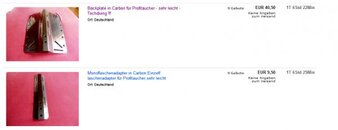victorzamora
Contributor
First, a lay-up of carbon and a 3-4mm plywood would be more than sufficient for doubles (strength-wise) but would be vulnerable to banging at the edges of the plate. I'd do biased reinforcement on the edges, personally, but there are several options that would work. Either way, I'd never make it out of just carbon. In the end, the weight savings would be minimal if you had a composite layup like that.
A core made of 3-4mm plywood would be very hard to manufacture with sufficient strength as to not create huge stress concentrations right at the weakest part of the core. Also, not only would the edges be weak, but wherever you placed holes (for either attachments for doubles or worse: attachment for single's wing sex screws as well as two cambands) would be very likely to delaminate. Even with reinforcing strips, even short-term loading of force on the plate will cause delamination after a few dives. With a wooden core, delamination would be the VERY abrupt end of the backplate's life span. A better core, if this was going to be attempted regardless, I think, would be a nomex honeycomb. However, that would necessitate a vacuum pump.
Second, I agree you will get the best results if you use one but a vacuum system it's far from a necessity. I have several items (though not Backplates, kayak paddles, kayaks, etc) I've made without one that have stood up to hard use for 10 years now. It will reduce weight of the resin and get better bonding but it's not a requirement at all. That said, it's not that hard to put one together with a home vacuum to at least get some level of improvement over a hand lay-up.
Something that has to support a force (like kayak paddles or kayaks) spread over a large distance is VASTLY different from the point-forces applied onto a backplate. Scuba tanks put a large force focused on a relatively small area. On top of that, the stress placed on the backplate by the harness is also putting point loads over a small area. Right where the harness goes from the center grommet into the shoulder harness, there is very little material. Something as soft as thin plywood simply won't hold up to much diving...especially when you're jumping in to water.
Third, other than the cost of carbon and resin, it wouldn't really be that expensive when considering how much you'd actually need. That said, I wouldn't go out and buy it just for this project, personally. I would certainly give it a try if I had it on hand and was inclined to build a project like this. In fact I seriously considered doing just that last year but decided I didn't really see the point of a light-weight plate once I got used to my SS.Good carbon will be "expensive"....but you're right, it's not atrociously expensive. However, getting any sort of performance out of a wood-core carbon composite backplate with any sort of longevity practically requires a good vacuum pump, vacuum bag, and everything that goes with it.
I've done a lot of work with composites in the field of Aerospace Engineering with UAV's over a wide range of sizes, but I do have a narrow view of composites....so I have experience, but I still may be wrong. I simply don't see it being a good idea at all.




